 The Bridge Report, which brought a turning point in the history of Budapest
A travel report that changed the history of Pest and Buda, as well as Hungary. The little book contributed to the change of half a thousand years of legal customs and the implementation of an investment of unprecedented size and technical quality. This book was The Bridge Report [Hídjelentés in Hungarian].
The Bridge Report, which brought a turning point in the history of Budapest
A travel report that changed the history of Pest and Buda, as well as Hungary. The little book contributed to the change of half a thousand years of legal customs and the implementation of an investment of unprecedented size and technical quality. This book was The Bridge Report [Hídjelentés in Hungarian].
 The Bridge Report, which brought a turning point in the history of Budapest
A travel report that changed the history of Pest and Buda, as well as Hungary. The little book contributed to the change of half a thousand years of legal customs and the implementation of an investment of unprecedented size and technical quality. This book was The Bridge Report [Hídjelentés in Hungarian].
The Bridge Report, which brought a turning point in the history of Budapest
A travel report that changed the history of Pest and Buda, as well as Hungary. The little book contributed to the change of half a thousand years of legal customs and the implementation of an investment of unprecedented size and technical quality. This book was The Bridge Report [Hídjelentés in Hungarian].
 Drama on the university wall - The heroic monument was planned 95 years ago
In the constant hustle and bustle of the Egyetem Square in Pest, the students may not even notice the monument that decorates the short section of wall between the church and the central building of ELTE. However, it commemorates their predecessors, the heroes who fought for their country in World War I, and those who heroically helped them. The first design of the dramatically collapsing soldier was born in 1928, ninety-five years ago.
Drama on the university wall - The heroic monument was planned 95 years ago
In the constant hustle and bustle of the Egyetem Square in Pest, the students may not even notice the monument that decorates the short section of wall between the church and the central building of ELTE. However, it commemorates their predecessors, the heroes who fought for their country in World War I, and those who heroically helped them. The first design of the dramatically collapsing soldier was born in 1928, ninety-five years ago.
 If the efforts of 1848 had not failed, Szabadság Square would be somewhere else today
Do you know where Diadal Street or Szabad Sajtó Street was in 1848? Not where many would think. During the revolution of 1848, the street names of Pest and Buda also changed.
If the efforts of 1848 had not failed, Szabadság Square would be somewhere else today
Do you know where Diadal Street or Szabad Sajtó Street was in 1848? Not where many would think. During the revolution of 1848, the street names of Pest and Buda also changed.
 The story of a famous clothing factory in Józsefváros
Close to Nagyvárad Square, at the junction of Elnök Street and Orczy Road, there is a complex of buildings with a huge floor area. There is an office building, a jewellery store, a tailor shop, a communications technology company, a photography and video recording company, and even a table tennis club. In the 1960s and 1970s, one of the largest clothing manufacturers in the country operated behind the walls, but the story did not begin then but at the end of the 19th century.
The story of a famous clothing factory in Józsefváros
Close to Nagyvárad Square, at the junction of Elnök Street and Orczy Road, there is a complex of buildings with a huge floor area. There is an office building, a jewellery store, a tailor shop, a communications technology company, a photography and video recording company, and even a table tennis club. In the 1960s and 1970s, one of the largest clothing manufacturers in the country operated behind the walls, but the story did not begin then but at the end of the 19th century.
 Sightseeing flights over Budapest - This is how air travel was popularised 70 years ago
Seventy years ago, the Hungarian airline of the time, MASZOVLET, wanted to bring aviation closer to the general public, so it invited interested parties to a quarter-hour sightseeing flight. Many were flying for the first time, the oldest passenger was over 80 years old.
Sightseeing flights over Budapest - This is how air travel was popularised 70 years ago
Seventy years ago, the Hungarian airline of the time, MASZOVLET, wanted to bring aviation closer to the general public, so it invited interested parties to a quarter-hour sightseeing flight. Many were flying for the first time, the oldest passenger was over 80 years old.
 Luxury in the white cubes - 90-year-old modern villas in Buda
The Buda side of the capital, with its wonderful landscapes and fresh air, is still very attractive today, and it was like this even in the first half of the last century. Many people from Pest, which became especially crowded after the Treaty of Trianon, moved to the other side of the Danube and from the beginning of the thirties, they built modern-style villas on the hillsides. Pestbuda now presents two of them below, into which their residents moved ninety years ago.
Luxury in the white cubes - 90-year-old modern villas in Buda
The Buda side of the capital, with its wonderful landscapes and fresh air, is still very attractive today, and it was like this even in the first half of the last century. Many people from Pest, which became especially crowded after the Treaty of Trianon, moved to the other side of the Danube and from the beginning of the thirties, they built modern-style villas on the hillsides. Pestbuda now presents two of them below, into which their residents moved ninety years ago.
 The downfall of the first Hungarian railway
Technical problems, and price competition caused by rivals caused the loss of the first Hungarian railway line. The company, which started with high hopes, suspended its activities 195 years ago. This was the Pest-Kőbánya suspension railway.
The downfall of the first Hungarian railway
Technical problems, and price competition caused by rivals caused the loss of the first Hungarian railway line. The company, which started with high hopes, suspended its activities 195 years ago. This was the Pest-Kőbánya suspension railway.
 Parking garage in the historic inner city
Cars everywhere - this characterised Budapest 50 years ago. Parking was thought to be part of the modern city. In Budapest, there were more and more cars, but the number of parking spaces did not increase fast enough, and a parking garage for 350 vehicles in the very centre of the inner city wanted to help with this.
Parking garage in the historic inner city
Cars everywhere - this characterised Budapest 50 years ago. Parking was thought to be part of the modern city. In Budapest, there were more and more cars, but the number of parking spaces did not increase fast enough, and a parking garage for 350 vehicles in the very centre of the inner city wanted to help with this.
 Stone coffin in front of the Parliament - The Monument of National Martyrs was unveiled 89 years ago
Statues of many statesmen can be seen in front of the Parliament, which is why the Monument of National Martyrs, located next to Kossuth Square, on Vértanúk Square, receives relatively little attention. The dignified work even in its simplicity commemorates the victims of the proletarian power after World War I. After five years of preparation, it was unveiled on 18 March 1934, exactly eighty-nine years ago.
Stone coffin in front of the Parliament - The Monument of National Martyrs was unveiled 89 years ago
Statues of many statesmen can be seen in front of the Parliament, which is why the Monument of National Martyrs, located next to Kossuth Square, on Vértanúk Square, receives relatively little attention. The dignified work even in its simplicity commemorates the victims of the proletarian power after World War I. After five years of preparation, it was unveiled on 18 March 1934, exactly eighty-nine years ago.
 Pest and Buda in 1848
Perhaps the best-known Hungarian historical date is 15 March 1848. But what was the city of Pest and Buda like 175 years ago, where a few literary young men recited poems and printed a manifesto in a heightened mood, accompanied by a relatively large but peaceful crowd on that rainy March day, thus setting a new direction for the development of Hungary?
Pest and Buda in 1848
Perhaps the best-known Hungarian historical date is 15 March 1848. But what was the city of Pest and Buda like 175 years ago, where a few literary young men recited poems and printed a manifesto in a heightened mood, accompanied by a relatively large but peaceful crowd on that rainy March day, thus setting a new direction for the development of Hungary?
 In the footsteps of Petőfi: A walk around the sites of the Revolution of 15 March in Pest and Buda
The sites of the Revolution of 15 March 1848 in Pest and Buda can still be visited today, and even some of the buildings that played an important role in the events are still there: standing in front of the National Museum, the Landerer and Heckenast Printing House, the Locotenential Council and the Táncsics-prison, anyone can recall the events.
In the footsteps of Petőfi: A walk around the sites of the Revolution of 15 March in Pest and Buda
The sites of the Revolution of 15 March 1848 in Pest and Buda can still be visited today, and even some of the buildings that played an important role in the events are still there: standing in front of the National Museum, the Landerer and Heckenast Printing House, the Locotenential Council and the Táncsics-prison, anyone can recall the events.
 Trauma and milestone - The story of the Pest-Buda flood of 1838
185 years ago, between 13 and 18 March 1838, the Danube flood, which is considered to be the largest in the history of the settlements in the area of today's Budapest, which had an independent public administration at the time, devastated the area. The natural disaster also called the ice flood, caused the most serious damage in Pest, which was at the dawn of development during the Reform Era. While in the other settlements, life returned to the previous state after the flood receded, in Pest, after the destruction, using more durable materials, it was possible to rebuild the city on a new scale.
Trauma and milestone - The story of the Pest-Buda flood of 1838
185 years ago, between 13 and 18 March 1838, the Danube flood, which is considered to be the largest in the history of the settlements in the area of today's Budapest, which had an independent public administration at the time, devastated the area. The natural disaster also called the ice flood, caused the most serious damage in Pest, which was at the dawn of development during the Reform Era. While in the other settlements, life returned to the previous state after the flood receded, in Pest, after the destruction, using more durable materials, it was possible to rebuild the city on a new scale.
 Tunnels instead of bridges? – An unrealised plan from the 19th century to connect Pest and Buda
The plan to build road tunnels under the Danube instead of bridges was seriously considered in Budapest already 130 years ago. Proponents argued that tunnels were cheaper, more sustainable and less militarily vulnerable. This idea was on the agenda for years, but the tunnels were not built in the end.
Tunnels instead of bridges? – An unrealised plan from the 19th century to connect Pest and Buda
The plan to build road tunnels under the Danube instead of bridges was seriously considered in Budapest already 130 years ago. Proponents argued that tunnels were cheaper, more sustainable and less militarily vulnerable. This idea was on the agenda for years, but the tunnels were not built in the end.
 The competition of the bridges was decided at a meeting
Should the Árpád or the Petőfi Bridge be built first? This was the dilemma that preoccupied the rebuilders of the bridges in Budapest in 1948. The question was not new, the same decision had to be made once 20 years earlier. At that time, the bridge at Boráros Square "won", but after the destruction of World War II, the question was again whether to continue the work with the blown-up bridge at Boráros Square or the half-finished Árpád Bridge.
The competition of the bridges was decided at a meeting
Should the Árpád or the Petőfi Bridge be built first? This was the dilemma that preoccupied the rebuilders of the bridges in Budapest in 1948. The question was not new, the same decision had to be made once 20 years earlier. At that time, the bridge at Boráros Square "won", but after the destruction of World War II, the question was again whether to continue the work with the blown-up bridge at Boráros Square or the half-finished Árpád Bridge.
 The first Hungarian female engineer was born 125 years ago - She wanted to build bridges, roads and railways
Eszter Pécsi, the first Hungarian female engineer, received her statics degree at Royal Joseph Polytechnic University on her 22nd birthday, making her the first female graduate engineer in the country. She notes the plans for the statics of the Alfréd Hajós Swimming Pool, but after 1945 she also took part in the revision of the capital's damaged buildings, as well as in the reinforcement work of the cracked roof of the National Theatre. She was responsible for the construction of several villas in the capital, such as the recently renovated Rózsi Walter Villa, which was designed by her husband, József Fischer. In Pestbuda's article, we remember the first Hungarian female engineer.
The first Hungarian female engineer was born 125 years ago - She wanted to build bridges, roads and railways
Eszter Pécsi, the first Hungarian female engineer, received her statics degree at Royal Joseph Polytechnic University on her 22nd birthday, making her the first female graduate engineer in the country. She notes the plans for the statics of the Alfréd Hajós Swimming Pool, but after 1945 she also took part in the revision of the capital's damaged buildings, as well as in the reinforcement work of the cracked roof of the National Theatre. She was responsible for the construction of several villas in the capital, such as the recently renovated Rózsi Walter Villa, which was designed by her husband, József Fischer. In Pestbuda's article, we remember the first Hungarian female engineer.
 The afterlife of a grain warehouse - The 140-year-old Elevator House on Boráros Square was a real sight
From the 1870s, huge construction works were carried out in Budapest, which was developing into a metropolis. Of course, the Hungarian capital, as the country's economic, commercial and industrial centre not only grew at an ever-accelerating rate in terms of its residential and public buildings, but its industrial sites also multiplied, and their sizes occupied an ever-larger area. An important logistics centre was established close to the southern connecting railway bridge.
The afterlife of a grain warehouse - The 140-year-old Elevator House on Boráros Square was a real sight
From the 1870s, huge construction works were carried out in Budapest, which was developing into a metropolis. Of course, the Hungarian capital, as the country's economic, commercial and industrial centre not only grew at an ever-accelerating rate in terms of its residential and public buildings, but its industrial sites also multiplied, and their sizes occupied an ever-larger area. An important logistics centre was established close to the southern connecting railway bridge.
 The pioneer of modern architecture - Virgil Borbíró was born 130 years ago
In the first half of the 20th century, Hungarian architectural public life was punctuated by many debates: at first, the Hungarian design language was at the centre, then from the second half of the 1920s, modern architecture. Virgil Borbíró took on a fighting role in the latter and fought determinedly for the new trend to gain ground. The engineer, who was born exactly one hundred and thirty years ago, left his mark on Hungarian cultural history not only with his buildings but also with his writings and organisational work.
The pioneer of modern architecture - Virgil Borbíró was born 130 years ago
In the first half of the 20th century, Hungarian architectural public life was punctuated by many debates: at first, the Hungarian design language was at the centre, then from the second half of the 1920s, modern architecture. Virgil Borbíró took on a fighting role in the latter and fought determinedly for the new trend to gain ground. The engineer, who was born exactly one hundred and thirty years ago, left his mark on Hungarian cultural history not only with his buildings but also with his writings and organisational work.
 The last expropriations: Dilapidated houses stood on the route of Erzsébet Boulevard
The Outer Ring Road in Budapest was built over a long period of time in several waves. One of the important turning points in the history of the construction of the road occurred in 1888 when the section from Margit Bridge to Üllői Road became completely open.
The last expropriations: Dilapidated houses stood on the route of Erzsébet Boulevard
The Outer Ring Road in Budapest was built over a long period of time in several waves. One of the important turning points in the history of the construction of the road occurred in 1888 when the section from Margit Bridge to Üllői Road became completely open.
 The radio is playing - Experimental broadcasting started 100 years ago
Regular public radio broadcasts started in Hungary at the end of 1925, but it was possible to listen to the radio in Hungarian in the country more than two years before public broadcasts began because experimental broadcasts started in March 1923.
The radio is playing - Experimental broadcasting started 100 years ago
Regular public radio broadcasts started in Hungary at the end of 1925, but it was possible to listen to the radio in Hungarian in the country more than two years before public broadcasts began because experimental broadcasts started in March 1923.
 The small mirror of Art Deco - The lesser-known side of Frigyes Spiegel, who died 90 years ago
Frigyes Spiegel wrote himself into the history of Hungarian architecture with his fantastic facades: his Art Nouveau buildings are the earliest appearances of the new style in the country. His genius naturally followed the changes of the times, and between the two world wars, he also left his mark on Art Deco - even if only to the extent of a single building. However, the historical circumstances also increase the value of this work of his, which also belongs to the elite in its category.
The small mirror of Art Deco - The lesser-known side of Frigyes Spiegel, who died 90 years ago
Frigyes Spiegel wrote himself into the history of Hungarian architecture with his fantastic facades: his Art Nouveau buildings are the earliest appearances of the new style in the country. His genius naturally followed the changes of the times, and between the two world wars, he also left his mark on Art Deco - even if only to the extent of a single building. However, the historical circumstances also increase the value of this work of his, which also belongs to the elite in its category.
 Károli Gáspár University of the Reformed Church turns 30 years old
Thirty years ago, the Synod of the Reformed Church, at its meeting on 24 February 1993, decided to found the Károli Gáspár University of the Reformed Church on the foundations of the Pest Reformed Theological Academy. The choice of name caused some controversy, but his work, the first complete Hungarian Bible translation, was in favour of Gáspár Károli, as it serves as the basis of universal Hungarian culture. University education started at 28 Ráday Street, the former seat of the theological academy, but due to the growing number of students, new locations had to be found. Nowadays, the students of the reformed university can study in such patinated buildings as the Károlyi-Csekonics Palace on Reviczky Street or the former Municipal School for Girls on Aréna Street.
Károli Gáspár University of the Reformed Church turns 30 years old
Thirty years ago, the Synod of the Reformed Church, at its meeting on 24 February 1993, decided to found the Károli Gáspár University of the Reformed Church on the foundations of the Pest Reformed Theological Academy. The choice of name caused some controversy, but his work, the first complete Hungarian Bible translation, was in favour of Gáspár Károli, as it serves as the basis of universal Hungarian culture. University education started at 28 Ráday Street, the former seat of the theological academy, but due to the growing number of students, new locations had to be found. Nowadays, the students of the reformed university can study in such patinated buildings as the Károlyi-Csekonics Palace on Reviczky Street or the former Municipal School for Girls on Aréna Street.
 The story of the preservation of a factory building in Ferencváros
The Laboratory Equipment Factory, completed in January 1963 at the corner of Tűzoltó Street and Thaly Kálmán Street, defined the streetscape of the neighbourhood for decades. Even when hundreds of workers worked in the building with a huge floor area, and even when it stood empty after 1990 and its condition deteriorated year by year. Nowadays, a modern dormitory, mainly inhabited by foreign university students, operates behind the walls, the new function also meant the rebirth of the building.
The story of the preservation of a factory building in Ferencváros
The Laboratory Equipment Factory, completed in January 1963 at the corner of Tűzoltó Street and Thaly Kálmán Street, defined the streetscape of the neighbourhood for decades. Even when hundreds of workers worked in the building with a huge floor area, and even when it stood empty after 1990 and its condition deteriorated year by year. Nowadays, a modern dormitory, mainly inhabited by foreign university students, operates behind the walls, the new function also meant the rebirth of the building.
 Where a movie star lived 100 years ago - Kálmán Rózsahegyi's villa
Kálmán Rózsahegyi was one of the greatest actors of the first half of the last century, in addition to his stage presence, he also played in many cult films. For his fiftieth birthday, his fans wanted to surprise him with a family house, for which they started a fundraiser. The plans were drawn up by Jenő Lechner a hundred years ago, in 1923, and he created a sumptuous luxury villa with his brilliant idea and great sense of style. Three years later, the actor was able to occupy his new home after returning home from the United States of America.
Where a movie star lived 100 years ago - Kálmán Rózsahegyi's villa
Kálmán Rózsahegyi was one of the greatest actors of the first half of the last century, in addition to his stage presence, he also played in many cult films. For his fiftieth birthday, his fans wanted to surprise him with a family house, for which they started a fundraiser. The plans were drawn up by Jenő Lechner a hundred years ago, in 1923, and he created a sumptuous luxury villa with his brilliant idea and great sense of style. Three years later, the actor was able to occupy his new home after returning home from the United States of America.
 Budapest then and today – 5 photos showing how much the city has changed
The capital, which is 150 years old this year, has changed so much over time that every day citizens can marvel at a section of a street, an old building that has disappeared or that has miraculously survived. This time, with the help of five pairs of images, Pestbuda presents the passage of time from the houses of the old inner city of Pest to the flood in Tabán.
Budapest then and today – 5 photos showing how much the city has changed
The capital, which is 150 years old this year, has changed so much over time that every day citizens can marvel at a section of a street, an old building that has disappeared or that has miraculously survived. This time, with the help of five pairs of images, Pestbuda presents the passage of time from the houses of the old inner city of Pest to the flood in Tabán.
 Gemstone along the Devil's Trench - The idea of the emerald church was born 90 years ago
A fantastic church is hidden among lavish villas, just a few hundred metres from the tram terminus in Hűvösvölgy. Its modern forms suggest that it was built in the 20th century, but visitors might not even imagine how long the work took - competing with medieval cathedrals, it was completed in several decades. However, the result was equally brilliant, the Gothic and modernism are perfectly combined in it. The idea of building the church in Remetekertváros was born ninety years ago, in 1933.
Gemstone along the Devil's Trench - The idea of the emerald church was born 90 years ago
A fantastic church is hidden among lavish villas, just a few hundred metres from the tram terminus in Hűvösvölgy. Its modern forms suggest that it was built in the 20th century, but visitors might not even imagine how long the work took - competing with medieval cathedrals, it was completed in several decades. However, the result was equally brilliant, the Gothic and modernism are perfectly combined in it. The idea of building the church in Remetekertváros was born ninety years ago, in 1933.
 It preceded the radio: The telephone herald was a Hungarian invention that delivered the news to the public immediately
When, thanks to Tivadar Puskás's invention, the Telephone Herald began operating in Budapest on 14 February 1893, radio broadcasting was still an unknown concept. The service, which delivered news read into a microphone via the telephone network, attracted the interest of the general public, which is not surprising. During these years, the Hungarian capital was under enormous development: palace-like public buildings and residential houses were completed one after the other, trams were already running on the roads, and the organisation of the millennium celebrations was in full swing, meaning that the new invention arrived in an optimistic era.
It preceded the radio: The telephone herald was a Hungarian invention that delivered the news to the public immediately
When, thanks to Tivadar Puskás's invention, the Telephone Herald began operating in Budapest on 14 February 1893, radio broadcasting was still an unknown concept. The service, which delivered news read into a microphone via the telephone network, attracted the interest of the general public, which is not surprising. During these years, the Hungarian capital was under enormous development: palace-like public buildings and residential houses were completed one after the other, trams were already running on the roads, and the organisation of the millennium celebrations was in full swing, meaning that the new invention arrived in an optimistic era.
 The young loves of Madách and Petőfi
In a voice of unclouded happiness, Imre Madách told his brother about the ball at which he danced with the love of his youth, Menyhért Lónyay's sister, Etelka Lónyay, but the unrequited love did not turn into a proposal. Petőfi had the courage to ask the daughter of a rich banker for her hand in marriage, but she offered it to Menyhért Lónyay. In connection with this year's Madách and Petőfi anniversaries, Pestbuda recalls the loves of youth, offering a glimpse into the world of reform-era balls.
The young loves of Madách and Petőfi
In a voice of unclouded happiness, Imre Madách told his brother about the ball at which he danced with the love of his youth, Menyhért Lónyay's sister, Etelka Lónyay, but the unrequited love did not turn into a proposal. Petőfi had the courage to ask the daughter of a rich banker for her hand in marriage, but she offered it to Menyhért Lónyay. In connection with this year's Madách and Petőfi anniversaries, Pestbuda recalls the loves of youth, offering a glimpse into the world of reform-era balls.
 The Chain Bridge was closed 50 years ago as well
The Chain Bridge was closed 50 years ago as well, as after its reconstruction in 1949, it needed to be renovated again. The works were timed for the 100th anniversary of the unification of Pest, Buda and Óbuda. The old painting had to be removed from a surface of 73,000 square metres, but at that time the 1949 coat of arms was also replaced with the version current in 1973.
The Chain Bridge was closed 50 years ago as well
The Chain Bridge was closed 50 years ago as well, as after its reconstruction in 1949, it needed to be renovated again. The works were timed for the 100th anniversary of the unification of Pest, Buda and Óbuda. The old painting had to be removed from a surface of 73,000 square metres, but at that time the 1949 coat of arms was also replaced with the version current in 1973.
 The father of the Lágymányos residential houses, architect József Fischer was born 150 years ago
Architect József Fischer was one of the important creators of the large-scale residential house constructions that began at the beginning of the 20th century. His buildings still define the image of Lágymányos. If people walk from the direction of Szent Gellért Square on Bartók Béla Road towards Móricz Zsigmond Square, or walk over to Budafoki Road, from here they turn into Zenta Street, they can see several residential houses that he listed. He designed around 25 houses in the capital, most of which are still standing today. Pestbuda now commemorates József Fischer, who was born 150 years ago.
The father of the Lágymányos residential houses, architect József Fischer was born 150 years ago
Architect József Fischer was one of the important creators of the large-scale residential house constructions that began at the beginning of the 20th century. His buildings still define the image of Lágymányos. If people walk from the direction of Szent Gellért Square on Bartók Béla Road towards Móricz Zsigmond Square, or walk over to Budafoki Road, from here they turn into Zenta Street, they can see several residential houses that he listed. He designed around 25 houses in the capital, most of which are still standing today. Pestbuda now commemorates József Fischer, who was born 150 years ago.
 There was once a theatre in the Class Lottery Palace - The history of the theatre began 105 years ago on Eskü Square
Where cars turn down today from the Erzsébet Bridge to the Pest embankment, before World War II, there stood a huge and beautiful building: the Class Lottery Palace. It was built at the turn of the century in the Neo-Baroque style, but Art Nouveau also left its mark on it. However, its interior was remodelled several times, most significantly for Vilma Medgyaszay's theatre. Jenő Lechner made its classicist plans in February 1918, exactly 105 years ago.
There was once a theatre in the Class Lottery Palace - The history of the theatre began 105 years ago on Eskü Square
Where cars turn down today from the Erzsébet Bridge to the Pest embankment, before World War II, there stood a huge and beautiful building: the Class Lottery Palace. It was built at the turn of the century in the Neo-Baroque style, but Art Nouveau also left its mark on it. However, its interior was remodelled several times, most significantly for Vilma Medgyaszay's theatre. Jenő Lechner made its classicist plans in February 1918, exactly 105 years ago.
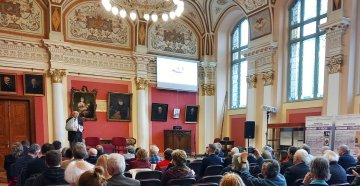 A message from the former school: An exhibition in memory of János Neumann was opened at the Fasori Secondary School
An exhibition was opened in János Neumann's former school, the Fasori Lutheran Secondary School, on the occasion of the 120th anniversary of the world-famous mathematician's birth. In the exhibition presenting the former Neumann milieu, paintings, graphics, photos, furniture, and objects tell the story of the art-supporting spirit of the noble bourgeois family at the turn of the century.
A message from the former school: An exhibition in memory of János Neumann was opened at the Fasori Secondary School
An exhibition was opened in János Neumann's former school, the Fasori Lutheran Secondary School, on the occasion of the 120th anniversary of the world-famous mathematician's birth. In the exhibition presenting the former Neumann milieu, paintings, graphics, photos, furniture, and objects tell the story of the art-supporting spirit of the noble bourgeois family at the turn of the century.
 The renovated Angyalföld Reformed Church was handed over
On 26 March, the renovated Frangepán Street Reformed Church was handed over. The 13th District church was built in 1933, the tower was restored in 2017, and the roof and facade were renovated last year. By the time of the ceremonial handover, the building had completely recovered its form ninety years ago.
The renovated Angyalföld Reformed Church was handed over
On 26 March, the renovated Frangepán Street Reformed Church was handed over. The 13th District church was built in 1933, the tower was restored in 2017, and the roof and facade were renovated last year. By the time of the ceremonial handover, the building had completely recovered its form ninety years ago.
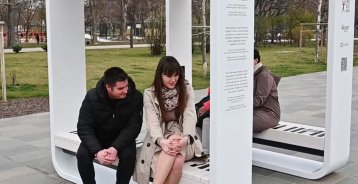 A musical smart bench was handed over in City Park
The City Park promenade has been enriched with a smart bench playing the works of Liszt and Chopin. The musical smart bench was presented to Budapest by the Polish Institute to commemorate the world-famous composers of the two nations.
A musical smart bench was handed over in City Park
The City Park promenade has been enriched with a smart bench playing the works of Liszt and Chopin. The musical smart bench was presented to Budapest by the Polish Institute to commemorate the world-famous composers of the two nations.
 The Arany János Street and Nyugati Railway Station metro stations were handed over
Metro line M3 runs again on the entire line, between Kőbánya-Kispest and Újpest Centre, but trains do not stop at Nagyvárad Square and Lehel Square. On 20 March, the renovated Arany János Street and Nyugati Railway Station metro stations were opened to passenger traffic, and access to the Dózsa György Road station became barrier-free.
The Arany János Street and Nyugati Railway Station metro stations were handed over
Metro line M3 runs again on the entire line, between Kőbánya-Kispest and Újpest Centre, but trains do not stop at Nagyvárad Square and Lehel Square. On 20 March, the renovated Arany János Street and Nyugati Railway Station metro stations were opened to passenger traffic, and access to the Dózsa György Road station became barrier-free.
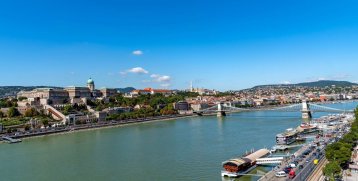 Budapest was chosen as one of the top 50 tourist destinations
Budapest is also included in Time magazine's list of 50 best tourist destinations. The American weekly with a readership of more than 50 million reports on the 150th anniversary of the unification of the capital, mentions the new attractions of the Buda Castle District, the Chain Bridge, the recently opened Museum of Ethnography and the House of Music Hungary, as well as the renovated Opera House. The reborn St. Stephen's Hall is also highlighted among the attractions.
Budapest was chosen as one of the top 50 tourist destinations
Budapest is also included in Time magazine's list of 50 best tourist destinations. The American weekly with a readership of more than 50 million reports on the 150th anniversary of the unification of the capital, mentions the new attractions of the Buda Castle District, the Chain Bridge, the recently opened Museum of Ethnography and the House of Music Hungary, as well as the renovated Opera House. The reborn St. Stephen's Hall is also highlighted among the attractions.
 The renewal of the City Park continues, the new National Gallery is also planned to be built
The Liget Budapest project continues with family-friendly developments, in addition to the recreational functions of the park, other green areas are also renewed: this year, the KRESZ park and its surroundings, the section of the Dvorák Promenade between the Museum of Ethnography and the House of Music Hungary, and the area surrounding the balloon observatory will also be renovated. The construction of the new National Gallery is also planned.
The renewal of the City Park continues, the new National Gallery is also planned to be built
The Liget Budapest project continues with family-friendly developments, in addition to the recreational functions of the park, other green areas are also renewed: this year, the KRESZ park and its surroundings, the section of the Dvorák Promenade between the Museum of Ethnography and the House of Music Hungary, and the area surrounding the balloon observatory will also be renovated. The construction of the new National Gallery is also planned.
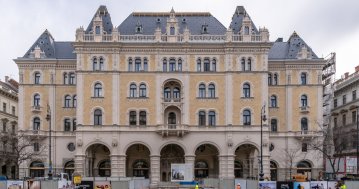 The facade of the Drechsler Palace, which is under renovation, can already be seen
The building at 25 Andrássy Avenue, the former Ballet Institute, known as the Drechsler Palace, was built for the Pension Fund of the Royal Hungarian State Railways according to the plans of Ödön Lechner and Gyula Pártos. The building is being converted into a five-star hotel, its facade is already visible. Pestbuda now presents some pictures of the building.
The facade of the Drechsler Palace, which is under renovation, can already be seen
The building at 25 Andrássy Avenue, the former Ballet Institute, known as the Drechsler Palace, was built for the Pension Fund of the Royal Hungarian State Railways according to the plans of Ödön Lechner and Gyula Pártos. The building is being converted into a five-star hotel, its facade is already visible. Pestbuda now presents some pictures of the building.
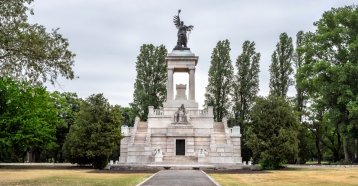 Visitors are invited to the 1848-49 memorial walk in the Fiumei Road Cemetery on 15 March
On 15 March, from 2 p.m., the National Heritage Institute will hold a walk at the Fiumei Road Cemetery National Memorial with the title "Memory of 1848-49". On the day of the holiday, people can also freely visit the largest tomb structures in the cemetery so anyone can look into the Batthyány, Deák and Kossuth Mausoleums.
Visitors are invited to the 1848-49 memorial walk in the Fiumei Road Cemetery on 15 March
On 15 March, from 2 p.m., the National Heritage Institute will hold a walk at the Fiumei Road Cemetery National Memorial with the title "Memory of 1848-49". On the day of the holiday, people can also freely visit the largest tomb structures in the cemetery so anyone can look into the Batthyány, Deák and Kossuth Mausoleums.
 Trains will be running again from 20 March on the entire M3 line on weekdays
Trains will be running again from 20 March on the entire M3 line, between Újpest Centre and Kőbánya-Kispest, but it is still not stopping at Lehel Square and Nagyvárad Square stations. The renovation of metro line 3 is expected to be completed in May.
Trains will be running again from 20 March on the entire M3 line on weekdays
Trains will be running again from 20 March on the entire M3 line, between Újpest Centre and Kőbánya-Kispest, but it is still not stopping at Lehel Square and Nagyvárad Square stations. The renovation of metro line 3 is expected to be completed in May.
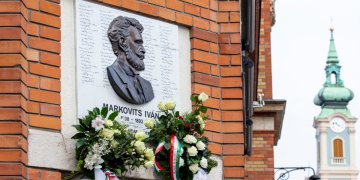 A memorial plaque was inaugurated on the building of the Batthyány Square Market Hall
At the junction of Markovits Iván Street and Batthyány Square in the 1st District, on the wall of the market hall built according to the plans of Pál Klunzinger, handed over in 1902, a memorial plaque was unveiled in honour of Iván Markovits, the creator of Hungarian shorthand.
A memorial plaque was inaugurated on the building of the Batthyány Square Market Hall
At the junction of Markovits Iván Street and Batthyány Square in the 1st District, on the wall of the market hall built according to the plans of Pál Klunzinger, handed over in 1902, a memorial plaque was unveiled in honour of Iván Markovits, the creator of Hungarian shorthand.
 Outdoor photo exhibition opened about the history of Andrássy Avenue
On the occasion of the 200th anniversary of the birth of Gyula Andrássy, an outdoor photo exhibition presenting the history of Andrássy Avenue can be seen from 6 March on Andrássy Avenue, between Oktogon and Kodály Körönd. The pictures, which were placed on the candelabras, show how traffic and the function of the road have changed. The photos also bring to life important historical moments.
Outdoor photo exhibition opened about the history of Andrássy Avenue
On the occasion of the 200th anniversary of the birth of Gyula Andrássy, an outdoor photo exhibition presenting the history of Andrássy Avenue can be seen from 6 March on Andrássy Avenue, between Oktogon and Kodály Körönd. The pictures, which were placed on the candelabras, show how traffic and the function of the road have changed. The photos also bring to life important historical moments.
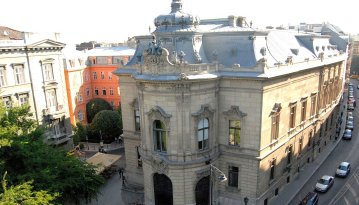 From eclecticism to brutalism: Budapest's protected buildings are presented
The exhibition titled "From Eclecticism to Brutalism: Architectural Assets Excavated in Budapest between 2017-2022" opens today at the Metropolitan Ervin Szabó Library. Through the buildings that have been placed under local protection in the past five years, the exhibition presents the change of architectural styles found in the capital from the end of the 19th century to the beginning of the 1970s.
From eclecticism to brutalism: Budapest's protected buildings are presented
The exhibition titled "From Eclecticism to Brutalism: Architectural Assets Excavated in Budapest between 2017-2022" opens today at the Metropolitan Ervin Szabó Library. Through the buildings that have been placed under local protection in the past five years, the exhibition presents the change of architectural styles found in the capital from the end of the 19th century to the beginning of the 1970s.
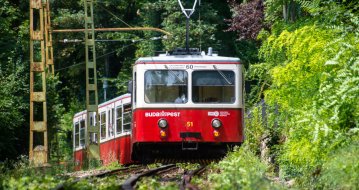 The cogwheel restarts in April
The cogwheel railway will start again on 1 April, the track was renovated during the winter break. It is a novelty that this summer the open nostalgia train will run several times between Városmajor and the Széchenyi Hill terminus.
The cogwheel restarts in April
The cogwheel railway will start again on 1 April, the track was renovated during the winter break. It is a novelty that this summer the open nostalgia train will run several times between Városmajor and the Széchenyi Hill terminus.
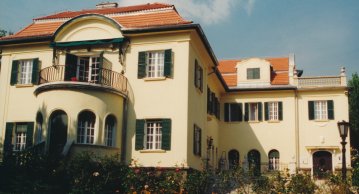 The Gizi Bajor Actors' Museum is reopening its doors
On 1 March, the Gizi Bajor Actors’ Museum in the 12th District reopens, where permanent and temporary exhibitions await those interested in theatre art. A villa walk is also held in the former home of Gizi Bajor, a permanent member of the National Theatre. Visitors can discover the secret spaces of the building that have been hidden from the public until now, from the basement that once hid refugees to the attic, as well as the mysterious corners of the garden.
The Gizi Bajor Actors' Museum is reopening its doors
On 1 March, the Gizi Bajor Actors’ Museum in the 12th District reopens, where permanent and temporary exhibitions await those interested in theatre art. A villa walk is also held in the former home of Gizi Bajor, a permanent member of the National Theatre. Visitors can discover the secret spaces of the building that have been hidden from the public until now, from the basement that once hid refugees to the attic, as well as the mysterious corners of the garden.
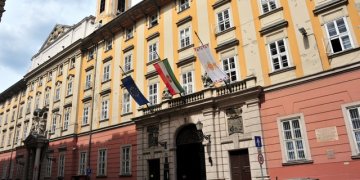 The capital decided on the naming of two public areas
The decision to name Diana Lane (Diana köz) located in Hegyvidék was made in 1985, and it has now been officially registered, and the hitherto anonymous continuation of the public area was also named Diana Lane. And in the 20th District, the name of Vereckei Street was clarified to the currently used Verecke Street.
The capital decided on the naming of two public areas
The decision to name Diana Lane (Diana köz) located in Hegyvidék was made in 1985, and it has now been officially registered, and the hitherto anonymous continuation of the public area was also named Diana Lane. And in the 20th District, the name of Vereckei Street was clarified to the currently used Verecke Street.
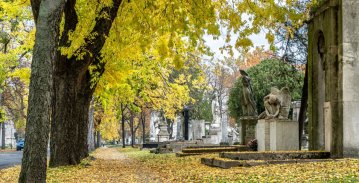 A memorial site is being prepared in the Fiumei Road Cemetery for Hungarians whose resting place is not in the country
The National Heritage Institute wishes to create a symbolic place of remembrance in the Fiumei Road Cemetery, which serves as a memorial site for all the former compatriots who do not have a resting place within Hungary's borders, either because their graves are located in other countries, or because the 20th century's traumatic events did not allow them to be buried anywhere.
A memorial site is being prepared in the Fiumei Road Cemetery for Hungarians whose resting place is not in the country
The National Heritage Institute wishes to create a symbolic place of remembrance in the Fiumei Road Cemetery, which serves as a memorial site for all the former compatriots who do not have a resting place within Hungary's borders, either because their graves are located in other countries, or because the 20th century's traumatic events did not allow them to be buried anywhere.
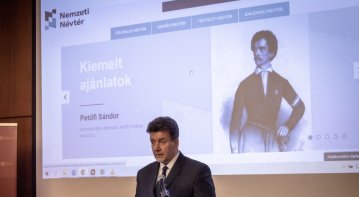 The Hungarian National Name Directory was expanded in cooperation with OSZK and NÖRI
The National Széchényi Library and the National Heritage Institute presented the new results of the expansion of the Hungarian National Name Directory. Thanks to the cooperation, from 16 February, the material of the Personal Name Directory, Geographical Name Directory and Board Name Directory will be connected to the database of memorial places, in which memorial places across the border will also appear. The digital interface is an interconnected network of people, geographical places, bodies, and memorial sites that are important for national memory, and is accessible to everyone.
The Hungarian National Name Directory was expanded in cooperation with OSZK and NÖRI
The National Széchényi Library and the National Heritage Institute presented the new results of the expansion of the Hungarian National Name Directory. Thanks to the cooperation, from 16 February, the material of the Personal Name Directory, Geographical Name Directory and Board Name Directory will be connected to the database of memorial places, in which memorial places across the border will also appear. The digital interface is an interconnected network of people, geographical places, bodies, and memorial sites that are important for national memory, and is accessible to everyone.
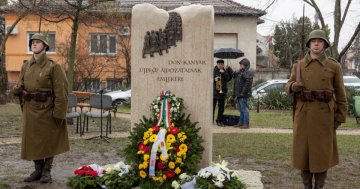 A monument was erected in Újpest to the soldiers who died at the Don River
A memorial was inaugurated in the 4th District in honour of the Újpest soldiers who fell at the Don River in World War II. The work depicts the last marching column of soldiers marching far into the distance, on the reverse side of which five soldiers' graves can be seen.
A monument was erected in Újpest to the soldiers who died at the Don River
A memorial was inaugurated in the 4th District in honour of the Újpest soldiers who fell at the Don River in World War II. The work depicts the last marching column of soldiers marching far into the distance, on the reverse side of which five soldiers' graves can be seen.
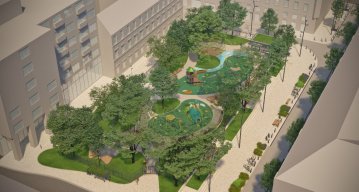 Hild Square in the 5th District will be beautified by autumn
Many people do not even know that Hild Square in the 5th District, which is being renovated, did not exist as a public space before, because there was a building here until 1944-45. The basement level of the destroyed house has remained to this day, which makes it difficult to replace the soil. Despite the difficulties, many new trees will be planted, there will be new shaded areas, vertical green surfaces, new public benches, a table tennis table and an accessible playground. Residents of the area can take possession of the renovated area in autumn.
Hild Square in the 5th District will be beautified by autumn
Many people do not even know that Hild Square in the 5th District, which is being renovated, did not exist as a public space before, because there was a building here until 1944-45. The basement level of the destroyed house has remained to this day, which makes it difficult to replace the soil. Despite the difficulties, many new trees will be planted, there will be new shaded areas, vertical green surfaces, new public benches, a table tennis table and an accessible playground. Residents of the area can take possession of the renovated area in autumn.
 The 125th anniversary of the death of Miklós Barabás was commemorated in the Fiumei Road Cemetery
Miklós Barabás was one of Hungary's most significant artists, and on the occasion of the 125th anniversary of his death, a wreath was laid on Friday at his tomb in the Fiumei Road Cemetery, which was made by Ede Telcs. It was said at the event: the portraits of the painter are important documents of the era, indispensable sources of Hungarian memory.
The 125th anniversary of the death of Miklós Barabás was commemorated in the Fiumei Road Cemetery
Miklós Barabás was one of Hungary's most significant artists, and on the occasion of the 125th anniversary of his death, a wreath was laid on Friday at his tomb in the Fiumei Road Cemetery, which was made by Ede Telcs. It was said at the event: the portraits of the painter are important documents of the era, indispensable sources of Hungarian memory.
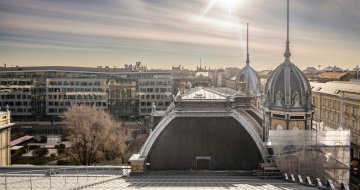 The renovation of Nyugati Railway Station continues with spectacular developments
In addition to the renovation of the north-west tower on the Teréz Boulevard facade of the Nyugati Railway Station, work will also begin on the south-east tower. The protective roof in front of the renewed facade is expected to be demolished in autumn.
The renovation of Nyugati Railway Station continues with spectacular developments
In addition to the renovation of the north-west tower on the Teréz Boulevard facade of the Nyugati Railway Station, work will also begin on the south-east tower. The protective roof in front of the renewed facade is expected to be demolished in autumn.
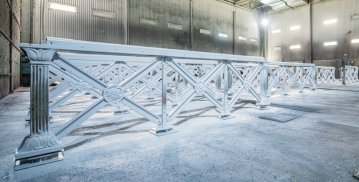 The railings of the Chain Bridge are being painted
They are already painting the railings and historical elements returning to the sidewalks of the Chain Bridge. A significant part of the bridge's 704-metre railing structure was remanufactured due to damage caused by rust. Eight arched parapet castings are reconstructed based on archival photos to match the appearance of the Chain Bridge in 1914-1915.
The railings of the Chain Bridge are being painted
They are already painting the railings and historical elements returning to the sidewalks of the Chain Bridge. A significant part of the bridge's 704-metre railing structure was remanufactured due to damage caused by rust. Eight arched parapet castings are reconstructed based on archival photos to match the appearance of the Chain Bridge in 1914-1915.
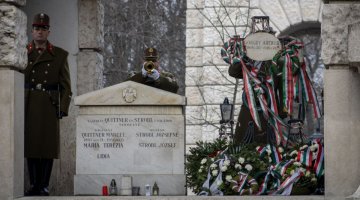 Artúr Görgei was remembered in the Fiumei Road Cemetery
General Artúr Görgei, Minister of War, was remembered on the 205th anniversary of his birth at his grave in the Fiumei Road Cemetery. It was said: Görgei is a historical figure whose historical role has been found at both extremes of the scale from traitor to hero in the last 150 years.
Artúr Görgei was remembered in the Fiumei Road Cemetery
General Artúr Görgei, Minister of War, was remembered on the 205th anniversary of his birth at his grave in the Fiumei Road Cemetery. It was said: Görgei is a historical figure whose historical role has been found at both extremes of the scale from traitor to hero in the last 150 years.
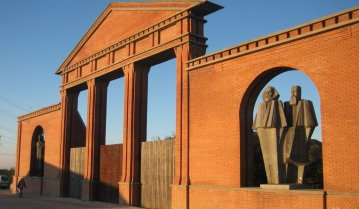 Memento Park has been classified as one of the most endangered heritage sites in Europe
The European heritage protection organisation Europa Nostra and the European Investment Bank Institute have selected 11 European heritage sites, seven of which could be included in the program to help save European heritage. The Memento Park in Budapest and the building of the Ottó Herman Museum in Miskolc are also on the list of must-be-saved sites.
Memento Park has been classified as one of the most endangered heritage sites in Europe
The European heritage protection organisation Europa Nostra and the European Investment Bank Institute have selected 11 European heritage sites, seven of which could be included in the program to help save European heritage. The Memento Park in Budapest and the building of the Ottó Herman Museum in Miskolc are also on the list of must-be-saved sites.
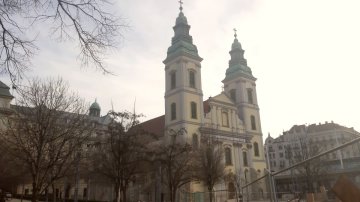 Where time began in 1048: the 975th anniversary of the founding of the parish is celebrated in the Inner City Church
In 2023, the Budapest Inner City Parish Church of the Blessed Virgin Mary will celebrate the 975th anniversary of its foundation: the congregation was established in 1048, during the time of Andrew I. On the occasion of this holiday, a commemorative year was announced in the Inner City Church, which is the oldest medieval monument in Pest.
Where time began in 1048: the 975th anniversary of the founding of the parish is celebrated in the Inner City Church
In 2023, the Budapest Inner City Parish Church of the Blessed Virgin Mary will celebrate the 975th anniversary of its foundation: the congregation was established in 1048, during the time of Andrew I. On the occasion of this holiday, a commemorative year was announced in the Inner City Church, which is the oldest medieval monument in Pest.
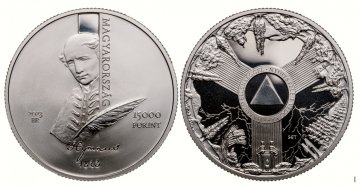 The central bank issued a collector coin on the 200th anniversary of the writing of the National Anthem
On the occasion of the 200th anniversary of the writing of the National Anthem, the Hungarian National Bank (HNB) issued silver collector coins with a face value of 15,000 HUF and non-ferrous metal ones with a face value of 3,000 HUF. On the obverse of the coin, the portrait of Ferenc Kölcsey can be seen, as well as the inscription Hymnus according to the original spelling and the year 1823 indicating the year of creation of the work.
The central bank issued a collector coin on the 200th anniversary of the writing of the National Anthem
On the occasion of the 200th anniversary of the writing of the National Anthem, the Hungarian National Bank (HNB) issued silver collector coins with a face value of 15,000 HUF and non-ferrous metal ones with a face value of 3,000 HUF. On the obverse of the coin, the portrait of Ferenc Kölcsey can be seen, as well as the inscription Hymnus according to the original spelling and the year 1823 indicating the year of creation of the work.
 The renewed Deák Ferenc Square and Ferenciek Square stations on metro line 3 were handed over
In the early afternoon of 23 January, Ferenciek Square and Deák Ferenc Square stations on metro line 3 were opened to passenger traffic, after which it is possible to travel between Kőbánya-Kispest and Deák Ferenc Square. The complete reconstruction of the line is scheduled to be completed in May 2023.
The renewed Deák Ferenc Square and Ferenciek Square stations on metro line 3 were handed over
In the early afternoon of 23 January, Ferenciek Square and Deák Ferenc Square stations on metro line 3 were opened to passenger traffic, after which it is possible to travel between Kőbánya-Kispest and Deák Ferenc Square. The complete reconstruction of the line is scheduled to be completed in May 2023.
 Bicycle-friendly developments are starting in three districts
Public procurement tenders were announced for the development of the bicycle network in the 2nd, 3rd and 13th Districts. The works will start this summer, their goal is to increase the safety of bicycle traffic and to encourage cycling.
Bicycle-friendly developments are starting in three districts
Public procurement tenders were announced for the development of the bicycle network in the 2nd, 3rd and 13th Districts. The works will start this summer, their goal is to increase the safety of bicycle traffic and to encourage cycling.
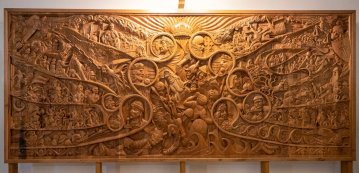 A National Anthem relief was inaugurated in the Offices of the National Assembly building
On the occasion of the Day of Hungarian Culture, the relief entitled National Anthem was inaugurated in the Offices of the Members of the National Assembly building at 19 Széchenyi Embankment, which bears the name of István Barankovics. The five-metre-long work of woodcarving artist Róbert Smidt depicts the fateful events of Hungary's thousand-year history.
A National Anthem relief was inaugurated in the Offices of the National Assembly building
On the occasion of the Day of Hungarian Culture, the relief entitled National Anthem was inaugurated in the Offices of the Members of the National Assembly building at 19 Széchenyi Embankment, which bears the name of István Barankovics. The five-metre-long work of woodcarving artist Róbert Smidt depicts the fateful events of Hungary's thousand-year history.
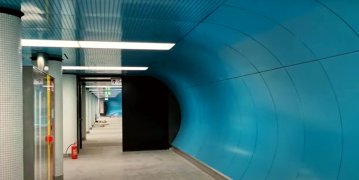 A mix of retro atmosphere and colours at the Deák Ferenc Square metro station
The Deák Ferenc Square metro station will be opened to traffic on Monday, but it has already become clear what kind of sight will greet the passengers when they go down to the underpass. The designers' vision was to create a contemporary retro feel with tubular spaces and the use of a variety of colours, yellow, blue, turquoise and white.
A mix of retro atmosphere and colours at the Deák Ferenc Square metro station
The Deák Ferenc Square metro station will be opened to traffic on Monday, but it has already become clear what kind of sight will greet the passengers when they go down to the underpass. The designers' vision was to create a contemporary retro feel with tubular spaces and the use of a variety of colours, yellow, blue, turquoise and white.
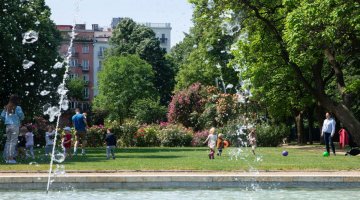 Mini forest, bushes, rows of trees: green developments from Főkert in 2023
This year, Főkert will renew several rows of trees in Budapest, plant 12,000 trees and make a mini-forest. Several previously started works are continuing, including park renovations, and benches are being placed in the small forests planted last year.
Mini forest, bushes, rows of trees: green developments from Főkert in 2023
This year, Főkert will renew several rows of trees in Budapest, plant 12,000 trees and make a mini-forest. Several previously started works are continuing, including park renovations, and benches are being placed in the small forests planted last year.
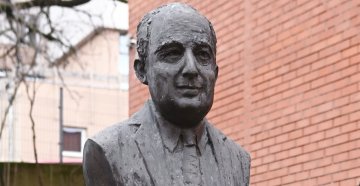 The János Neumann memorial year has begun
Óbuda University announced the launch of the János Neumann memorial year yesterday, the world-famous scientist's statue was laid with a wreath in the institution's garden, and an all-day scientific conference was held. On the occasion of the 120th anniversary of the mathematician's birth, the Neumann Society is holding countless programs and events until the end of December 2023, with which it tries to introduce the Hungarian public to everything the world owes to János Neumann, who was born in Budapest and died in Washington.
The János Neumann memorial year has begun
Óbuda University announced the launch of the János Neumann memorial year yesterday, the world-famous scientist's statue was laid with a wreath in the institution's garden, and an all-day scientific conference was held. On the occasion of the 120th anniversary of the mathematician's birth, the Neumann Society is holding countless programs and events until the end of December 2023, with which it tries to introduce the Hungarian public to everything the world owes to János Neumann, who was born in Budapest and died in Washington.
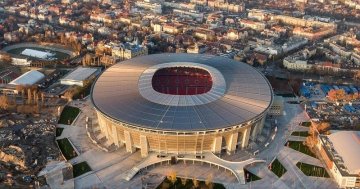 The capital would be suitable for hosting the Olympics - according to Balázs Fürjes
If, based on the previous evaluation, Hungary would have been capable to host the Olympics, then it is even more capable to do so now, Balázs Fürjes stated. According to him, in addition to the completed sports facilities, the hotel infrastructure is also suitable for such an event.
The capital would be suitable for hosting the Olympics - according to Balázs Fürjes
If, based on the previous evaluation, Hungary would have been capable to host the Olympics, then it is even more capable to do so now, Balázs Fürjes stated. According to him, in addition to the completed sports facilities, the hotel infrastructure is also suitable for such an event.
 A tender is announced for the presentation of the values and identity of the city districts
In connection with the 150th anniversary of the unification of Pest, Buda and Óbuda, the Budapest Cultural Centre has announced a tender to which cultural institutions maintained by the district local councils can apply. Support can be obtained for the organisation of cultural and artistic programs and events that express the identity of the district and present the specificities of the district.
A tender is announced for the presentation of the values and identity of the city districts
In connection with the 150th anniversary of the unification of Pest, Buda and Óbuda, the Budapest Cultural Centre has announced a tender to which cultural institutions maintained by the district local councils can apply. Support can be obtained for the organisation of cultural and artistic programs and events that express the identity of the district and present the specificities of the district.
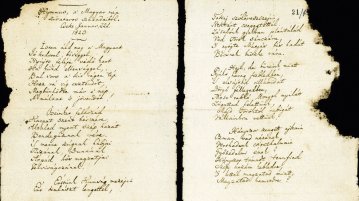 The birthday of the National Anthem: the Ministry of Culture invites people to a joint recitation
On the Day of Hungarian Culture, 22 January, on the 200th anniversary of the National Anthem, 200 children, 100 from the motherland and 100 from abroad, will recite Hungary's national poem on the main steps of the Parliament. At the same time, one of the most important Hungarian poems of all time will be recited in four locations across the border, as well as in Ferenc Kölcsey's former residence, Szatmárcseke, and in Veszprém, which has been awarded the title of European Capital of Culture.
The birthday of the National Anthem: the Ministry of Culture invites people to a joint recitation
On the Day of Hungarian Culture, 22 January, on the 200th anniversary of the National Anthem, 200 children, 100 from the motherland and 100 from abroad, will recite Hungary's national poem on the main steps of the Parliament. At the same time, one of the most important Hungarian poems of all time will be recited in four locations across the border, as well as in Ferenc Kölcsey's former residence, Szatmárcseke, and in Veszprém, which has been awarded the title of European Capital of Culture.
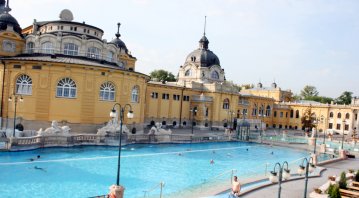 The Széchenyi Thermal Bath is among the seven best thermal baths in Europe
According to a British newspaper, the Széchenyi Thermal Bath in Budapest is one of the best thermal baths in Europe. In the compilation published yesterday, the bath's Neo-Baroque building, its medicinal water and its 21 pools are mentioned.
The Széchenyi Thermal Bath is among the seven best thermal baths in Europe
According to a British newspaper, the Széchenyi Thermal Bath in Budapest is one of the best thermal baths in Europe. In the compilation published yesterday, the bath's Neo-Baroque building, its medicinal water and its 21 pools are mentioned.
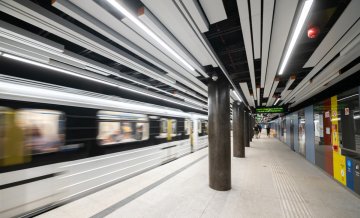 The Deák Square and Ferenciek Square metro stations will be handed over on 23 January
The Ferenciek Square and Deák Ferenc Square metro stations will be opened to passengers on 23 January. According to the plans, the metro will run on the entire line from the middle of March, and from the middle of May, passengers will also be able to use the last renovated Nagyvárad Square and Lehel Square stations.
The Deák Square and Ferenciek Square metro stations will be handed over on 23 January
The Ferenciek Square and Deák Ferenc Square metro stations will be opened to passengers on 23 January. According to the plans, the metro will run on the entire line from the middle of March, and from the middle of May, passengers will also be able to use the last renovated Nagyvárad Square and Lehel Square stations.
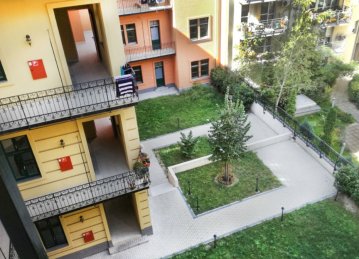 Call for applications for the greening of inner courtyards and street facades
The Budapest City Council announced a tender for the creation of greener, more flowery inner courtyards and the greening of street facades.
Call for applications for the greening of inner courtyards and street facades
The Budapest City Council announced a tender for the creation of greener, more flowery inner courtyards and the greening of street facades.
